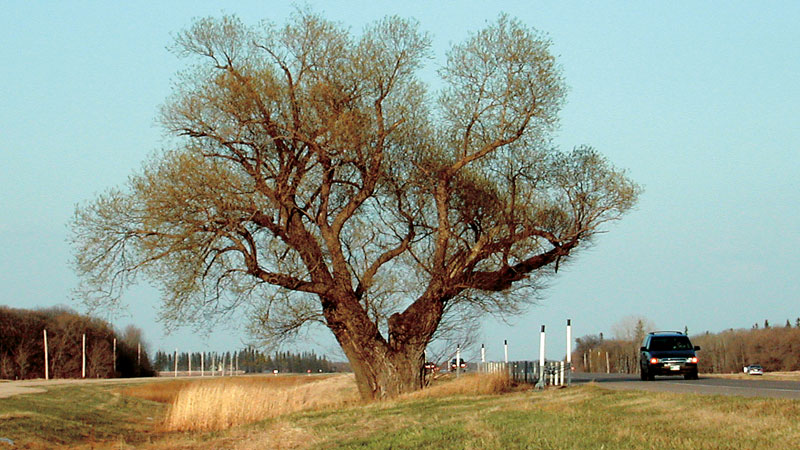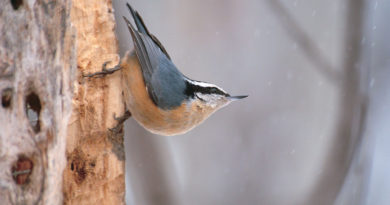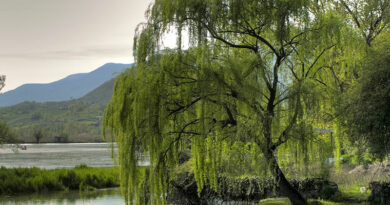Manitoba’s Halfway Tree
by Joan Cohen
It’s a tree beloved of Manitobans who regularly commute the 194 km along the TransCanada highway between Winnipeg and Brandon.
“You look at it every time you pass,” says Brandon MLA Drew Caldwell, a former minister in Gary Doer’s NDP government. He is also as an unabashed tree lover. He nominated this laurel leaf willow, back in 1985, to be honoured as a Heritage Tree of Manitoba. Heritage trees were honoured as a project of the Manitoba Forestry Association.
The “fabulous” Halfway Tree, 20 km west of Portage la Prairie, was examined, measured and photographed. It was ultimately entered onto Manitoba’s honour roll of special trees as a historical treasure. During the time, it was 11 metres tall, with a crown spread of 16 metres and diameter of 185 cm at breast height. The tree is over a century old. Remarkably, it is cared for by a descendent of the farmer who planted it.
Planted in 1872
Shortly after he took possession of the land back in 1872, Walter Smith planted a laurel leaf willow. It was on either side of the driveway which during those days led to his home. One of the trees eventually died. Many years later, Smith’s daughter would tell the Brandon Sun she could not remember a time when the remaining big laurel tree was not there. Through the decades, the Halfway Tree has caught the eye of the public and the press.
Peter Kuch pays tribute
In 1948, Winnipeg Free Press cartoonist Peter Kuch put pen to paper to rhapsodize, verbally, about the “very old”, very vigorous tree “spreading like an umbrella over the [nearby] ditch”, and speculate that at “about 75” it might be the oldest willow on the prairies. In the 1950s, Manitoba Hydro, concerned that the wide-spreading tree would damage its lines, was going to cut it down, a huge job. Faced with protests, Hydro reached an agreement with the owner to trim the tree and therefore left it in place.
Save that tree!
The twinning of the TransCanada Highway west of Portage, in 1973, consequently put this increasingly famous tree in danger. The new north portion of the highway was built right beside where the tree stood. It looked like its fate was sealed. Once again, though, travellers along the TransCanada made their concerns known. They pleaded with the provincial highways department not to remove the heritage tree. Again the authorities relented, and the highways department and landowner Don Coubrough, Walter Smith’s grandson, reached an agreement allowing the tree to remain. Coubrough remembers seeing construction vehicles circling the tree, scraping away the earth to put down the new roadway. A 100-foot long steel guardrail was later put up to protect the tree from passing vehicles.
Disaster strikes
Neither the guardrail nor its heritage status later protected the Halfway Tree. In October, 2000, a transport truck, with its driver asleep at the wheel, plunged into the ditch just east of the tree. He ran smack into it. The truck’s cab and much of the back was crumpled. The driver’s wife, in the passenger seat, suffered two broken legs.
Ardythe McMaster and her husband Don, a skilled landscape painter, are both naturalists, deeply interested in trees and wildlife. Ardythe spotted the damaged tree and waited for someone to do something about it. Nothing happened, and she finally felt she had to act. She contacted the Manitoba Forestry Association and brought the tree’s plight to the attention of a local women’s club. The women quickly drew up a petition, sending it to the highways department.
The highways department, pressed by the Forestry Association’s Diane Beaven, reluctantly agreed to hire an arborist. Roy St. Lawrence pruned the tree and finally removing the damaged wood.
Willows are resilient
Roy had some encouraging words for the women. If someone’s going to drive a truck into a tree, he said, make sure it’s a willow. Willows are resilient. They can survive a heavy knock. Roy removed some broken branches about mid-way up the canopy of the large old tree. He also took out some dead wood. The damage wasn’t extensive. But a huge branch that used to lean out toward the highway, seemingly poised to sweep the passing cars, now arches well overhead.
Lightning strikes
There would be one more crisis. In 2002, lightning struck the tree, stripping away bark that the elements carried right up to the Coubrough farmhouse. It broke off some small branches. Again, the wounds were soon hidden by new growth. The wet weather of the 2004 growing season brought an extra surge of green. Bold and vast and handsome you see it now as, heading westward, you round a curve in the TransCanada just west of Highway 16.
Still standing
Today, TransCanada travellers will tell you the Halfway Tree is more glorious than ever. Coubrough, however, disputes this. He can see that the years and the mishaps have taken their toll. In the 1970s, Don says, you could stand under the tree in a rainstorm and never get wet.
The raised stretch of land where the tree stands beside the highway long ago passed into the hands of the province. Walter Smith’s family has continued to own and farm the adjacent land, raising grain and mixed crops. Great grandson Kevin, Don’s son, farms it now. But Don still proudly hoards a little pile of press clippings which hold the precious story of Manitoba’s Halfway Tree.




